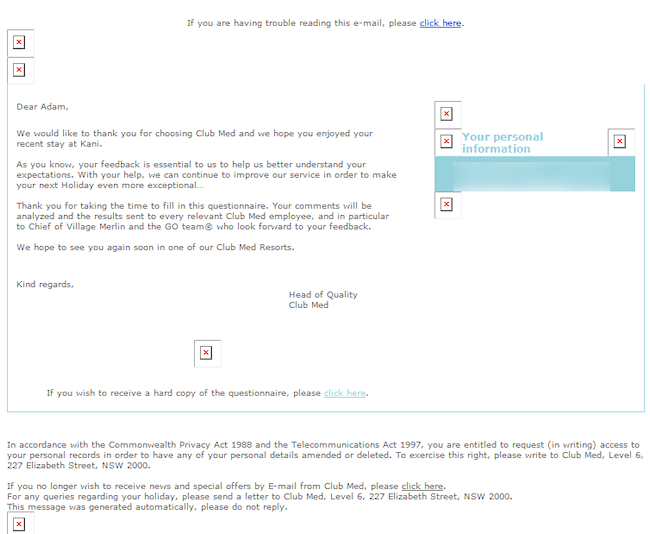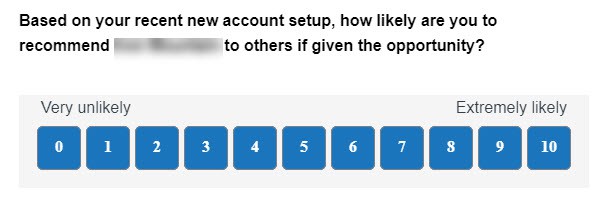Getting high response rates for your customer feedback survey starts with asking the respondent to fill in your survey by creating an effective customer satisfaction survey email template.
Your email needs to make people want to start the survey but it doesn’t have to be long and complex.
In fact it should be short and to the point.
Remember the only goal of the invite is to persuade the respondent to provide their feedback on your organisation.
In this post I’ll show you how to write a survey email template for your NPS, customer satisfaction or customer feedback survey that can generate response rates of 20%, 30% or more.
- 1. A Great Subject Line
- 2. Email Invite Personalisation
- 3. Tell Them Why They are Receiving the Invite
- 4. Don't Tell Them How Great You Are
- 5. Explain the Purpose of the Survey
- 6. Give a Realistic Estimate of the Time it Will Take
- 7. Give Them a Place to Ask Questions
- 8. Show Them the Survey Link
- 9. Mention the Incentive, or Not
- 10. Create a Sense or Urgency, if Appropriate
- 11. Embed The First Question to Boost Response Rates
- 12. Thank Them
- 13. Include a Signature Block
- 14. Comply with Local Email Sending Legislation
- 15. Send a Reminder
- Customer Feedback Survey Email Invite FAQs
1. A Great Subject Line
The first thing your invitee will see is the email subject line so make it a good one.
Here is a checklist of things to consider when writing the your subject line:
- Don’t Over Complicate it and Be Sincere
- Avoid Spammy Words and Capitals
- Make it About the Customer
- Be Specific not Vague, Deceptive or “Creative”
- Subject Line Length: 4-7 Words
- The Email “From” Address Should Be A Person
- You Probably Should Not Use Emojis 😥
For more details check out this blog post: Email Subject Lines that Maximise Customer Feedback Survey Responses
2. Email Invite Personalisation
Remember your respondent gets lots of emails each day and some simple personalisation can set you apart.
Name Personalisation
This is very simple to do but make sure that it’s in line with your business’s brand identity or brand voice.
“Dear Mr. Smith,”
“Hi John,”
“Hey John,”
“Yo Jonny”
Never use “Dear Valued Client” – no one that ever received a message with that introduction ever felt valued – in fact the often feel exactly the reverse!
Content Personalisation
If your respondent may have had more than one interaction with you it can be a good idea to add a comment or reference to the interaction. This increased specificity will improve response rates and the relevance of feedback.
We’re keen to hear what you thought of [product name].
Sign-off Personalisation
Your invite should always be signed off by an appropriate person in the organisation. Never send it from an anonymous “Customer Care Centre” or similar goup.
The simple act of putting a real person’s name at the bottom of the email will lift response rates by 50%.
If you are able take the next step and personalise the invite to be from a person the invitee knows or knows of, e.g. their account manager or regional General Manager.
3. Tell Them Why They are Receiving the Invite
Give the respondent some context for the survey invite; tell them who is being asked to respond and/or why they have been selected.
With email phishing attacks constantly on the rise you need to reassure your survey respondent. It also answers a common concern of email recipients: why am I getting this request?
Here are a couple of example templates – you’ll need to align it with your actual reason:
“You are receiving this invite because you recently shopped at our site.”
or
“We are inviting you because you are a valuable client.”
4. Don’t Tell Them How Great You Are
Some companies add a line near the start of an survey email that goes something like this:
We are the market leader and provide a great service. So we can do even better…
Resist the urge to do the same. It doesn’t increase the chance the invitee will respond it just adds words to the email and biases the start of the responses you will receive.
Try to keep your introduction as neutral as possible.
5. Explain the Purpose of the Survey
Okay, these days most (all?) people will have seen a customer feedback or Net Promoter Score survey so you don’t need to go into lots of detail but you do need to put the purpose in their terms.
Remember: they care much less about how you will benefit from the time they are investing in the survey and much more about how they will benefit.
So, ensure you put the purpose and value of the survey in the respondent’s terms.
For instance:
So we can provide you an even better experience we are collecting feedback on how we performed in our last engagement.
OR
We actively use feedback to constantly improve our delivery and provide you with the best possible service.
6. Give a Realistic Estimate of the Time it Will Take
Shorter is always better in customer feedback survey terms but regardless of how long the survey is you should give a specific and accurate estimate of the time it will likely take.
Be specific: say “10 minutes” not “a short time”. Specific times are more believable than vague times.
Resist the urge to deliberately under-state this time. Respondents still answering questions after 20 minutes, when told it will take 10 minutes, will be unhappy with your brand and provide more negative scores in the survey.
Try:
“Based on past experience this survey will take 5 minutes.”
OR
“Typically it takes 3 minute to complete.”
7. Give Them a Place to Ask Questions
Put some simple contact details in your email invite. A very small number of people will use them ask questions.
Many more will be reassured that they could have contacted you if they wanted to. This lends credibility to the invite and increases response rates.
This can be as simple as:
If you have any questions please contact John Smith at john.smith@ourcompany.com
8. Show Them the Survey Link
Make sure you include a clear link to the survey and call to action.
Some organisations use an image for the survey link but many email clients hide images by default. If the image is blocked it will be hard for respondents to see.
Take this invite I received recently:

If you are going to use this approach make sure you provide a simple text link as well as the image.
Also, make sure that the link has a good amount of clear space around it so it doesn’t get lost in the message: maybe even underline and bold the link to make it stand out.
Try:
Lorem ipsum dolor sit amet, consetetur sadipscing elitr, sed diam nonumy eirmod tempor invidunt ut labore et dolore magna aliquyam erat, sed diam voluptua. At vero eos et accusam et justo duo dolores et ea rebum.
Click here to start the survey.
Stet clita kasd gubergren, no sea takimata sanctus est Lorem ipsum dolor sit amet. Lorem ipsum dolor sit amet, consetetur sadipscing elitr, sed diam nonumy eirmod tempor invidunt ut labore et dolore magna aliquyam erat, sed diam voluptua.
9. Mention the Incentive, or Not
With a well written invite, engaged audience and a properly designed customer feedback survey you should not need to include an incentive to achieve effective response rates.
However, you may want to include one anyway.
Incentives, such as discounts or free products, can be useful for lifting response rates for customer feedback surveys. But they should tailored to the individual customer to be even more effective.
Effective types of incentives include competitions, charitable donations or social recognition.
Here is a full breakdown of the best customer feedback survey incentives: The Best Customer Feedback Survey Incentives
10. Create a Sense or Urgency, if Appropriate
If your survey has a closing date, mention it in the invite to provide a sense not just of urgency but also to give respondent an understanding of your time line.
Surveys are a “job to be done” by your respondent. If you give them a date by which the job needs to be done it can improve response rates.
11. Embed The First Question to Boost Response Rates
As an extension of showing them the survey link, you can boost response rates from your invite by 50% if you embed the first survey question in the email itself.
We always use this in our NPS survey email templates and other customer feedback style surveys.
You should not use images for this question to avoid the issues noted earlier in this section. Instead use HTML colour codes.

12. Thank Them
The respondent is doing you a favour by providing their feedback, so you should thank them for their effort. It can be a simple but sincere thank you.
Thank you for providing your feedback. We appreciate the time you have taken and will actively use it to improve our services to you.
13. Include a Signature Block
If you have followed our best practices on survey email subject lines this survey email invite will be coming from a real person so include a real person’s signature block.
If it is going to a large number of respondents you may like to remove some elements such as the cell/mobile phone number. Other than that it should be similar or the same as your standard email signature.
This will also ensure that it is “on brand” with your organisation.
14. Comply with Local Email Sending Legislation
Email sending legislation varies around the world and you should abide by your local requirements.
That being said, in general*, as this is a customer feedback survey you will have an existing commercial relationship with the respondent and this negates many of the anti-SPAM restrictions that marketing emails come up against.
However, it is still good practice to comply with any marketing email requirements your country enforces as email recipients have come to expect these elements in commercial email.
Postal Address
You should include clear text explaining where you are located and a valid postal address.
Unsubscribe Requests
It is also good practice to include an unsubscribe mechanism to allow respondents to remove themselves from the invite list.
15. Send a Reminder
Once you’ve written a great survey invite go ahead and create a reminder to send 3-5 days after the primary invite.
Sending a reminder will generally lift response rates by 50% so it’s an easy way to drive additional responses for very little extra effort.
It should follow the same rules as suggested already – don’t make it identical but it can be very similar.
Oh – and don’t send more than one or, maximum, two reminders. Any more that that will annoy respondents and their responses will be more negative.
Customer Feedback Survey Email Invite FAQs
Typically you don’t email the survey form itself. Email still has limitations and doesn’t operate like a full webpage. The best practice is to email a link to your web based survey. A good customer feedback company will be able to manage this for you.
The best way is to engage with your customer in plain language. Ask them for their assistance and clearly show them the link to your survey. Remember the survey is itself a part of the overall customer experience.
Keep it simple. The old What, Why, Who and How are a great summary of the things that every customer satisfaction survey invite should include.
When sending a customer feedback survey invitation, it’s important to include the purpose of the survey, as well as instructions on how to complete it. If applicable be sure to provide a deadline for when the survey should be completed and let the customer know that their input is valuable and appreciated.
When designed correctly your survey may not even need an incentive but you if you do there are three approaches: promise an incentive for every response, enter the respondent into a lottery or pay a smaller incentive to every invitee and rely on the significant reciprocation drive in the human psyche.
* Disclaimer: This information is not legal advice. We’re not lawyers and while we have been in the customer feedback business for a while you should contact your legal group to get their final take on the legislation.





